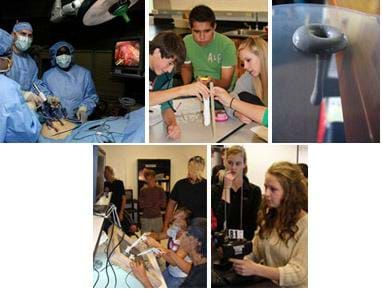
Summary
Through this unit, students act as engineers who are given the challenge to design laparoscopic surgical tools. After learning about human anatomy and physiology of the abdominopelvic cavity, especially as it applies to laparoscopic surgery, students learn about the mechanics of elastic solids, which is the most basic level of material behavior. Then, they explore the world of fluids and learn how fluids react to forces. Next, they combine their understanding of the mechanics of solids and fluids to understand viscoelastic materials, such as those found in the human body. Finally, they learn about tissue mechanics, including how collagen, elastin and proteoglycans give body tissues their unique characteristics. In the culminating hands-on activity, student teams design their own prototypes of laparoscopic surgical robots—remotely controlled, camera-toting devices that must fit through small incisions, inspect organs and tissue for disease, obtain biopsies, and monitor via ongoing wireless image-taking. They use a (homemade) synthetic abdominal cavity simulator to test and iterate the prototype devices.Engineering Connection
Biomechanical engineers work closely with laparoscopic surgeons to develop surgical procedures and tools. Biomechanical engineers must have an understanding of anatomy, physiology and surgery in order to communicate well with surgeons and other medical professionals. They also must have an understanding of materials properties so as to study pathologies and design implants and devices that function reliably and safely in the human body. Engineers partner with surgeons to create, design, test and manufacture new tools, devices and prosthetics—a partnership that helps to advance life-saving and life-enhancing technologies.
Unit Overview
At the beginning of the unit, as part of lesson 1, introduce the culminating engineering design challenge of the unit, which is the design project described in the Designing a Robotic Surgical Device activity. After lesson 1, have student teams conduct its associated Challenges of Laparascopic Surgery activity as a hook to engage them in the subsequent lessons. Then present the mechanics of biomaterials lessons and activities (lessons 2, 3, 4 and 5, and their associated activities). After lesson 5 is presented, conduct the concluding design activity to complete the design challenge.
Educational Standards
Each TeachEngineering lesson or activity is correlated to one or more K-12 science,
technology, engineering or math (STEM) educational standards.
All 100,000+ K-12 STEM standards covered in TeachEngineering are collected, maintained and packaged by the Achievement Standards Network (ASN),
a project of D2L (www.achievementstandards.org).
In the ASN, standards are hierarchically structured: first by source; e.g., by state; within source by type; e.g., science or mathematics;
within type by subtype, then by grade, etc.
Each TeachEngineering lesson or activity is correlated to one or more K-12 science, technology, engineering or math (STEM) educational standards.
All 100,000+ K-12 STEM standards covered in TeachEngineering are collected, maintained and packaged by the Achievement Standards Network (ASN), a project of D2L (www.achievementstandards.org).
In the ASN, standards are hierarchically structured: first by source; e.g., by state; within source by type; e.g., science or mathematics; within type by subtype, then by grade, etc.
See individual lessons and activities for standards alignment.
Subscribe
Get the inside scoop on all things TeachEngineering such as new site features, curriculum updates, video releases, and more by signing up for our newsletter!Unit Schedule
The following schedule provides the recommended sequence to conduct the lessons and activities, which have been designed to be taught as a cohesive unit.
Lesson 1: Abdominal Cavity and Laparoscopic Surgery (100 minutes)
Activity: Challenges of Laparoscopic Surgery (55 minutes)
Activity: Using Hooke's Law to Understand Materials (50 minutes)
Lesson 2: Mechanics of Elastic Solids (75 minutes)
Lesson 3: Viscous Fluids (50 minutes)
Activity: Measuring Viscosity (80 minutes)
Activity: Creepy Silly Putty (first half of 60 minutes)
Lesson 4: Viscoelasticity (50 minutes)
Activity: Creepy Silly Putty (last half of 60 minutes)
Activity: Preconditioning Balloons: Viscoelastic Biomedical Experiments (30 minutes)
Lesson 5: Tissue Mechanics (25 minutes)
Activity: Designing a Robotic Surgical Device (two versions: 47 or 38 hours)
More Curriculum Like This

Students are introduced to the abdominopelvic cavity—a region of the body that is the focus of laparoscopic surgery—as well as the benefits and drawbacks of laparoscopic surgery.

Student teams create laparoscopic surgical robots designed to reduce the invasiveness of diagnosing endometriosis and investigate how the disease forms and spreads. Using a synthetic abdominal cavity simulator, students test and iterate their remotely controlled, camera-toting prototype devices, whi...

Students learn why engineers must understand tissue mechanics in order to design devices that will be implanted or used inside bodies, to study pathologies of tissues and how this alters tissue function, and to design prosthetics. Students learn about collagen, elastin and proteoglycans and their ro...

Students teams use a laparoscopic surgical trainer to perform simple laparoscopic surgery tasks (dissections, sutures) using laparoscopic tools. Just like in the operating room, where the purpose is to perform surgery carefully and quickly to minimize patient trauma, students' surgery time and mista...
Other Related Information
Learn more about the creation of this curricular unit, which was based on engineering graduate student work:
Brandi N. Briggs, Benjamin S. Terry, Janet L. Yowell and Stephanie Rivale. (2011) Incorporating Biomechanical Research Topics into K-12 Classroom Design Projects to Broaden Participation and Increase Engineering Interest. Proceedings, ASME 2011 International Mechanical Engineering Congress and Exposition, November 11-17, 2011, Volume 5, Denver, CO. Paper #IMECE2011-64530. http://proceedings.asmedigitalcollection.asme.org/proceeding.aspx?articleid=1643683
Pre-Engineering Biomedical Curriculum Highlights Value of Engineering for High Schoolers. Published November 10, 2011. eNotes, College of Engineering and Applied Science, University of Colorado Boulder. Accessed November 10, 2011. http://ecadw.colorado.edu/enotes/current/
Copyright
© 2011 by Regents of the University of ColoradoContributors
Benjamin S. Terry, Brandi Briggs, Stephanie RivaleSupporting Program
Integrated Teaching and Learning Program, College of Engineering and Applied Science, University of Colorado BoulderAcknowledgements
This digital library content was developed by the Integrated Teaching and Learning Program under National Science Foundation GK-12 grant no. DGE 0338326. However, these contents do not necessarily represent the policies of the National Science Foundation, and you should not assume endorsement by the federal government.
Last modified: February 25, 2020







User Comments & Tips